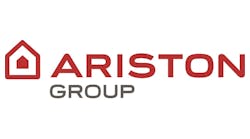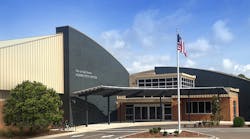When Hurricane Ivan washed across the waterfront community of Gulf Breeze, Florida, in 2004, the storm did little damage to the town’s 29-year-old recreation center. Yet, this same storm provided the impetus for a $6.2 renovation and expansion of the center, which included a host of high-efficiency building systems, among them a geothermal heating, ventilation and air-conditioning (HVAC) system.
Gulf Breeze is located on Fairport Peninsula in Santa Rosa County, part of the Florida Panhandle. The small city of 6,400 people is a residential community across the bay from Pensacola, Florida, and is connected to Pensacola by a three-mile bridge. The city’s mission is to “…preserve and enhance the hometown character and natural environment to foster a high quality of family life.”
Living out that mission, Gulf Breeze constructed a 20,000-sq.ft. recreation center in 1985. That first Gulf Breeze Recreation Center included a dual-court gymnasium and two large multi-purpose rooms that, according to Parks and Recreation Director Ron Pulley, were always full. When approximately $15 million in Federal Emergency Management Agency (FEMA) funds became available to the city in the aftermath of Hurricane Ivan, officials opted to apply a portion of the money to renovate and expand the well-worn community center.
Prior to finalizing plans for the new center, the city held a series of public meetings for citizens to provide their input. The result is a 24,000-sq.ft. addition that more than doubles the size of the original structure, bringing to 44,000 — the number of square feet in the Gulf Breeze Community Center.
The structure boasts a new entry and lobby, two dual-court gymnasiums, four multi-purpose rooms, a game room, a full-service commercial kitchen, free wireless Internet access and an exterior covered porch that overlooks 10 exterior tennis courts, tiered landscaped seating and a tennis pro shop.
Exercise in environmental responsibility
As those who designed the building looked for ways to provide services to the community, they also considered ways to exercise environmental responsibility, both in the way the building was designed and the way it operated.
The project incorporated a number of highly efficient building systems, including high-efficiency LED and fluorescent lighting, daylight harvesting, low-voltage lighting controls, spray foam insulation and a new geothermal heating and cooling system that provides 100 percent of the facility’s heating and cooling. As a result, the community center is a United States Green Building Council Leadership in Energy and Environmental Design (LEED) certified building.
Before deciding to install the geothermal system, the community carefully considered two other options.
“The City of Gulf Breeze has a natural gas concession,” said Pulley. “One of the first things we talked about was the opportunity to use natural gas for our full HVAC system. But, the technology for natural-gas-powered air conditioning was relatively new, and we felt there just weren’t enough qualified service technicians in the area to be comfortable with that choice.
“The other option was a traditional HVAC system,” added Pulley. “But when we sat down with the architects, listened to their proposal for geothermal and looked at the potential savings over what we determined to be the life expectancy for the facility, it became clear that the geothermal system would quickly pay for itself.”
Community endorses geothermal
After the decision was made to go geothermal, changes to the original plan were made to address several concerns. For instance, the original design called for a series of wells to be sunk under the building slab. Additionally, the plan included a 60-ton cooling tower to serve as a backup for the 129-ton geothermal system.
“We looked at the cost of a 60-ton cooling tower versus the cost of adding additional loops to provide system redundancy,” said Pulley. “By adding 40 loops to the geothermal system and expanding it from 90 to 130 loops, we could save $30,000, achieving the necessary backup to the HVAC system without having to purchase a cooling tower. So we modified the original plan, adding 40 loops and moving all the loops out from under the building and into a storm water retention area behind the facility.”
The community center tapped the skills of Pensacola-based Energy Systems and owner Danny Marshall to install the geothermal system. By his own estimation, Marshall attributes 80 percent to 85 percent of his company’s business to geothermal installations.
“We do it all, from start to finish,” he said. “We have our own drilling rig, so we’re able to prepare the ground for the loop, install the loop, do the fusing and set up the equipment for a seamless installation.”
System boasts 130 loops
In the case of the community center, Marshall was instrumental in the design of the geothermal system, which called for the installation of 130 loops in one large loop field. Each loop is 300 feet deep and ties into a header, along with 9 other loops.
“I used a huge vault for this project, which made it a bit more unusual than most of my installations,” noted Marshall. “The vault is really like a concrete and steel basement, in the ground and separate from the community center, that you access through a manhole and a ladder. Inside the vault, a sort of hallway is lined with supply and return valves for each loop, with 10 loops to a header. This enables me to valve a header off if we need to do a repair to the loop and then bring it back online.”
From the vault, 8-in. pipes run over to and into the community center’s mechanical room, home to 15 WaterFurnace Envision NXV, NDV and NSV geothermal heat pumps that range in size from 1 1/2 to 20 tons.
“We’ve been a customer of WaterFurnace since the 1990’s,” said Marshall. “So, we didn’t think twice about using their equipment for the community center. It offers the performance and efficiency across a broad range of sizes that enabled us to design a system that best meets the comfort and efficiency needs of the center. Just as importantly, the units were available with a reheat feature, which is critical for humidity control at the center.
“The geothermal system also eliminates the need for strip or auxiliary heat,” Marshall continued. “Because the ground temperature here in Florida is about 68 to 70 degrees, there is enough heat in the system without needing any kind of auxiliary heat. This results in significant savings during winter months when the building is cool enough to require heat.”
Comfortable, energy efficient
The Gulf Breeze Community Center opened in March 2013, and since then, the geothermal system has been working as anticipated.
“It gets very hot here, and I was concerned that the system wouldn’t be able to cool the facility as well as a traditional system,” said Pulley. “In fact, even in the middle of August, when it’s very, very hot outside and we have a number of activities going on inside and lots of bodies generating additional heat, we have people coming to us and asking us to turn off the air conditioning — that’s how well the geothermal system provides cooling.”
Pulley adds that the system is easy to operate and, with the exception of changing filters, requires no maintenance. “In addition, the fact that the heat pumps are located inside the building and out of sight, means people playing tennis or sitting on the porch don’t have to see units lined up against the building or listen to them as they turn on and off throughout the day.”
The new facility replaces one that Pulley said, “wore out, which is a good thing because it means we were providing something that the community wanted and used. Today we have a new community center that we expect to last a good 30 years — and that includes the geothermal system.
“Our goal is to fill the center every day, keep it busy and eventually wear it out,” said Pulley. “In the process, we’re focusing our attention on the young people living in our community and those yet to come, as well as older members, providing everyone with opportunities to learn, play, exercise and build relationships. WaterFurnace has to be proud to be affiliated with a project like this — one that promotes traditional values while incorporating new technologies designed to carry us well into the future, efficiently, comfortably and with sensitivity to the environment.”



